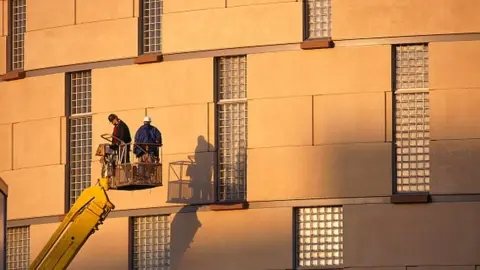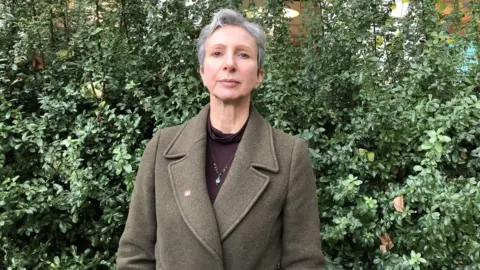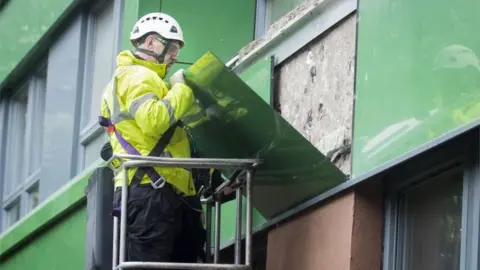Post-Grenfell cladding inspections find other fire risks
 Getty Images
Getty ImagesFire safety inspections have uncovered hundreds of blocks of flats in England and Wales with faulty or missing fire prevention measures, the BBC has found.
Flat owners have been looking for evidence of unsafe cladding in the wake of the Grenfell Tower fire that killed 72 people in 2017.
But many of the inspections have revealed problems inside the buildings.
The government said it was introducing the biggest improvements to building safety for 40 years.
'I'm living in an unsafe building'
When surveyors visited Lucy Seker's flat in central Manchester earlier this year, they found the cladding was compliant with safety standards.
But other fire safety issues, such as missing fire barriers in some of the cavities inside the flat, have left her and her neighbours facing repair bills of more than £30,000.
"At first, I thought I'm ok, there are far worse off than me. But because of the cavity issues I'm just as much at risk from fire and living in an unsafe building," she said.
 Lucy Seker
Lucy Seker"The impact has been monumental - shattering. I've worked hard all of my life and I now have a worthless property.
"Where am I going to find £30,000?"
The fire issues have seen her insurance costs rise by 300%, as well as a 40% increase in her service charge and residents must now also pay for a fire warden to guard the block.
"I don't feel safe in the building," she added. "If fire spread through the cavities, then how far could it get before anyone stops it?"
Fire breaks and 'compartmentation'
Many owners are now finding problems with "compartmentation" - the way their individual flat is sealed to stop fire and smoke spreading within a building.
Typically, flats should have barriers inside the spaces between any cladding and the outside walls, and fire breaks in the internal walls to ensure flats are protected for as long as possible should a fire break out.
 PA Media
PA MediaDorian Lawrence, whose company Façade Remedial Consultants has been inspecting the cladding on hundreds of blocks across England and Wales, said he has found defective fire safety in 90% of the 2,000 buildings he has inspected and around 60% of those are not cladding related.
"Post-Grenfell we've only really started taking cladding off buildings and taking a look behind to see what's there," he said.
"The issue is the building may look fantastic on the outside with the cladding correctly fitted, but once you've taken the cladding off, what we uncover is quite a mess in many instances.
"After Grenfell everyone realised perhaps their buildings were not compliant with building regulations and found a necessity to undertake the intrusive works to make sure [whether] they're compliant or not, and in the majority of cases, they are not."
Scale of the problem
While statistics showing the extent of the problem nationwide are scarce, a picture of the scale of internal wall defects is emerging in Manchester and London.
London Fire Brigade shared data with 5 Live Investigates showing that of the 576 blocks which have a "waking watch" - considered such a fire risk they need overnight fire wardens - more than 100 had compartmentation problems.
In Manchester, the problems are even more stark.
The Greater Manchester High-Rise Task Force, set up to assess fire safety in all of the city's tall residential blocks, has imposed "interim" safety measures such as fire wardens or extra fire alarms in around 100 buildings.
Of those, around 70 have other serious defects like missing or incorrectly-fitted cavity barriers and, in some cases, inadequate fire protection on the frame of the building.
Nigel Glen, of the Association of Residential Managing Agents, whose members are responsible for the day-to-day running of almost 1.5 million leasehold flats, said he had been trying to draw the government's attention to the problems.
"It is quite clear these defects are not the fault of the leaseholders and so they shouldn't be expected to pay for compartmentation failures," he said.
"The impact on residents and flat owners can only be that of yet more stress - both financial and mental. On property managers the emotional toll is proving to be massive - leaseholders are understandably frightened and angry and property managers are, in many cases, the only people that they have to hand to take matters out on."
Richard Beresford, chief executive of the National Federation of Builders, said the challenge is what to do with building work that was at the time within the rules, but now no longer meets safety standards.
"Government and industry know what needs to be done for future buildings and building work; ensuring a value-based rather than cost-based approach to buildings, the need for hand-in-glove working all along the supply chain on matters of safety, as well as much tighter building regulations and adequately funded and resourced building control.
"But what we still need is action for those who fall between the gap of legal and safe. Here the only answer is for government to intervene to resolve the ludicrous situation whereby remediation works fall on leaseholders and run to tens of thousands of pounds or more - rendering their flats unsellable."
The Ministry of Housing, Communities and Local Government said: "Building owners are responsible for ensuring their buildings are safe and residents should speak to their building owner if they are concerned.
"If a building contains a hazard or the measures in place do not sufficiently mitigate the risk to life from a fire, both Fire and Rescue Authorities and councils are responsible for enforcement and can take action."
